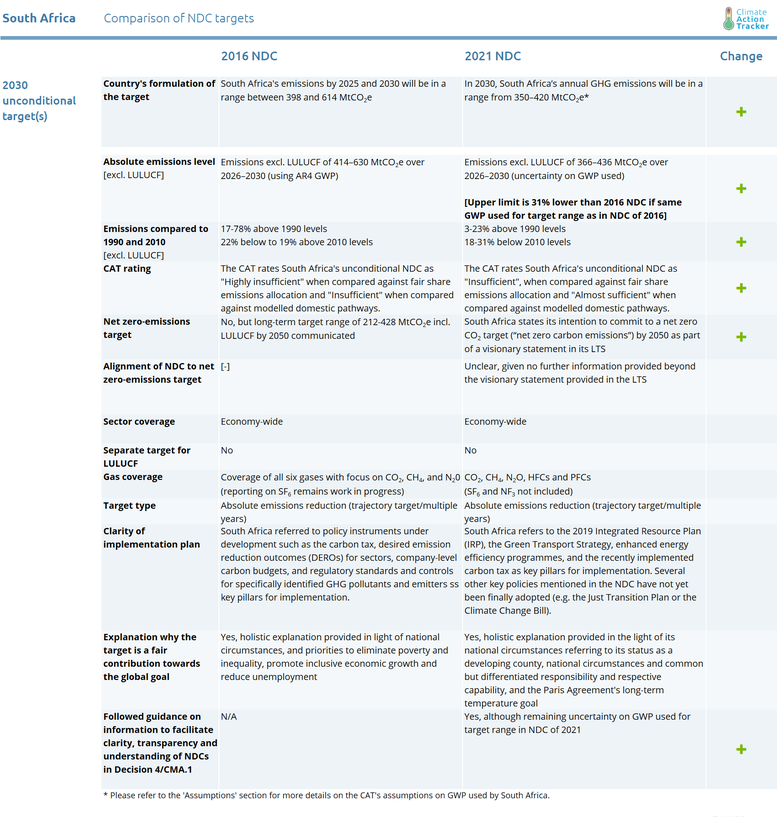CAT Climate Target Update Tracker
South Africa
Summary
South Africa submitted its updated NDC in September 2021. The update strengthened the country’s target range for 2030: the upper end is now 32% lower than in the previous NDC (incl. LULUCF), the lower end is 12% lower.
The CAT rates South Africa's upper bound of the new unconditional NDC target range as "Insufficient", when compared against its fair share emissions allocation and "Almost sufficient" when compared against modelled domestic pathways. Each rating against the two frameworks has improved by one category compared to the upper range of the previous NDC.
While the updated NDC of 2021 increased South Africa’s climate ambition towards 2030 and increased clarity, transparency and understanding, the target range is not yet in line with the Paris Agreement 1.5˚C temperature goal.
CAT analysis of NDC

South Africa submitted an updated NDC to the UNFCCC in September 2021 after a monthslong public consultation phase, following the recommendations of the Presidential Climate Commission (previously analysed by the CAT here). The updated NDC represents progress beyond its previous submission but may still not be compatible with limiting global warming to 2˚C above pre-industrial levels, let alone with the Paris Agreement’s 1.5°C limit.
In its updated NDC, South Africa commits to limiting its absolute emissions level to 350–420 MtCO2e (incl. LULUCF) by 2030. Both the upper and lower limit was changed downwards compared to the NDC of 2016. It is not clear to us which Global Warming Potential (GWP) is used to calculate the 350–420 MtCO2e range. Our analysis assumes these figures are based on AR4 values (see Assumptions section below).
Assuming LULUCF remains at the average level over 2007–2017 (-16 MtCO2e), the draft version of the updated NDC of 2021 translates to an emissions level of between 366–436 MtCO2e excluding LULUCF (18%–31% below 2010 levels). The updated NDC does not specifically mention whether the emissions range is an unconditional target, but the CAT interprets it as such.
South Africa states that the upper limit of the new 2030 target range is 32% below the upper limit of its previous NDC of 2016 target range for 2030 (614 Mt CO2e, incl. LULUCF). In its NDC, South Africa indicates that the revision of the upper limit is primarily determined by fair share considerations but does not provide details on how this was determined (e.g., sectoral contributions). The lower limit of the new target range is 12% below the lower limit of its previous NDC of 2016 target range for 2030 (398 Mt CO2e, incl. LULUCF).
The CAT rates South Africa's upper bound of the new unconditional NDC target range as "Insufficient", when compared against fair share emissions allocation and "Almost sufficient" when compared against modelled domestic pathways. Each rating against the two frameworks has improved by one category compared to the upper range of the previous NDC.
As South Africa only needs to reach the upper end of the target range to fulfil the NDC, we rate that emissions level. The bottom end of its target range sits on the border of what would be “1.5°C Paris Agreement compatible” when compared to modelled domestic pathways and is close to “1.5°C Paris Agreement compatible” but still “Almost sufficient” when compared its fair contribution.
South Africa refers to the 2019 Integrated Resource Plan (IRP), the Green Transport Strategy, enhanced energy efficiency programmes, and the recently implemented carbon tax as key pillars for implementing its updated NDC of 2021. South Africa also emphasises the need for financial support by the international community as specified by the Paris Agreement. The CAT considers the stringent implementation of the IRP and the overall management of the just transition away from coal as the key success factors for achieving South Africa’s NDC. No additional targets have been specified in the updated NDC.
South Africa intends to commit to a net zero CO2 target (“net zero carbon emissions”) by 2050 as part of a visionary statement in its Low-Emissions Development Strategy 2050 submitted to the UNFCCC. In this context, the National Planning Commission is in the process of developing a common, 2050, vision for South Africa and will subsequently update its targets. Given the preliminary nature of this statement, and the lack of detailed information, the CAT cannot evaluate the alignment of the updated NDC target range with the upcoming net zero CO2 target.
South Africa intents to submit a second NDC in 2025 and emphasises that its submission will be an update to its first NDC submitted in 2015.
Comparison table
Assumptions
Global Warming Potential (GWP)
It is unclear which GWP values have been used to calculate the target range of the updated NDC of 2021. The NDC states that its targets are based on the latest inventory report, which uses SAR values, and that the country will transition to using AR5 in 2024.
In its first NDC of 2016, South Africa’s target range was calculated using AR4 values. As the lower bound of the target range for 2025 is 398 MtCO2e (incl. LULUCF) in both the first NDC of 2016 and the updated NDC of 2021, we assume that South Africa has continued to use AR4 values for these figures, notwithstanding the values used in its inventory report. Furthermore, the comparison that “the upper end of the target range in 2025 has been reduced by 17%, and the upper end of the target range in 2030 has been reduced by 32%, and the lower range by 12%” points to comparing both target ranges in AR4.
We have not assessed the impact of changing to AR5 values; however, South Africa notes that this change is likely to increase total emissions by 10–20 Mt CO2.
LULUCF
We have assumed a ten-year historical average for LULUCF emissions based on national inventory data from 2007-2017 (i.e., -16 Mt CO2e) to obtain total emission levels excl. LULUCF (i.e., 366–436 Mt CO2e).
Links
Stay informed
Subscribe to our newsletter
